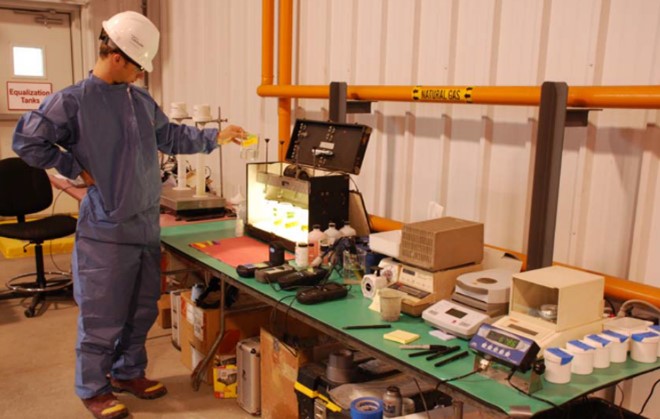The three most important keys for success for the sediment management/dewatering operations in any hydraulic dredging of pits, ponds and lagoons for municipalities, industrial manufacturing, or power plants are 1st Preparation, 2nd Preparation, and 3rd Preparation!

With more than 36 years of hands-on experience, Underwater Mineral Processing Services, LLC (UMPS), a division of Underwater Construction Corporation, provides dredged sediment dewaterability bench- and pilot-scale testing services for difficult and challenging projects. These test results support UMPS’ provision of client-customized turnkey sediment/sludge dredging and slurry dewatering services for municipal and industrial pits, ponds, and lagoons projects along with mine and aggregate plant tailings ponds applications.
1st Preparation: Problem Definition
- The first step of Problem Definition is addressed by UMPS, by having the client fill out and submit the “Spec Your Project” form at https://mpsmaine.com/spec-your-project/.
2nd Preparation: Design & Execution of a Bench / Pilot-Scale Dewaterability Testing
- With the information from the “Spec Your Project” form, UMPS can develop a proposal for performing a bench / pilot-scale treatability evaluation on representative sediment samples the client would secure.
- Development of a preliminary “process flow diagram” identifying the “top-level” unit process modules to achieve the optimal sediment dewatering based upon particle size and specific gravity.
- Geotube® & Smartfeed® polymer conditioning for sediment & sludge dewatering
- Continuous Belt Filter Press
- Plate & Frame Recessed Chamber Filter Press
- Decanting Centrifuge
- Development/execution of bench- and pilot-scale treatability testing to mimic the conceptual process flow diagram and anticipated sediment dewatering unit process operation.
- Confirm or amend conceptual process flow diagram for full-scale operations based upon the results of the bench- and pilot-scale treatability testing and the client’s project goals and objectives for success.
3rd Preparation: Pre-mobilization Planning
- Development of full-scale equipment list for sediment handling and processing with mass/flow balance calculations.
- Verification that client’s site has the necessary power and potable water utilities available or develop means and methods for their independent supply.
- Confirmation of adequate laydown area availability for dredged slurry management operations.
- Mechanical dredge slurry processing and excess dredge water treatment to meet regulatory permitted discharge criteria
- Prepared laydown area for Geotube® / geotextile tube dewatering/slack-drying operations
- Confirmation of sediment removal means & methods and anticipated production capabilities.
- Diver hand-vacuum, surgical dredging
- Robotic dredging unit (i.e., UMPS LWT Pit-Hog Auger Cutterhead Dredge)
- Hydraulic Dredge (i.e., Mud Cat Auger Cutterhead Dredge)
The following is an example of the UMPS’ development of a bench-scale test GeoTube® Sediment Dewatering Project Specification Sheet:
Dredged Materials Information:
- Type of Material to Be Dewatered:
- Volume of Sludge to Be Dewatered (cy):
- Specific Gravity of Solids Within Sludge:
- Pounds Per Gallon:
- Percent Solids of the In-situ Sludge:
- Percent Solids During Dredging Operation:
- Target Percent of Solids After Dewatering with Geotubes®:
- Percent of Coarse Grain Solids in The In-situ Sludge (expressed as a decimal):
Dredge Sediment Removal Production Rates:
- Dredge / Pumping Operation Rate (gpm):
- Dredge Pumping Hours Per Day:
- Dredge Operating Efficiency (expressed as a decimal):
Candidate Site Evaluation
Based upon the client’s level of interest, UMPS may wish to conduct an on-site evaluation of candidate Geotube®application laydown area for full-scale application. It is anticipated that this task could include a one-day site visit by UMPS
Bench-scale Tests
Chemical Program Study
STANDARD JAR TEST PROCEDURE
The standard jar test is a critical procedure for selecting the appropriate polymer for a particular clarification application. This procedure allows individual polymers to be compared on such criteria as floc formation, settling characteristics, and clarity. Generally, the best performing products provide fast floc formation, rapid settling rate, and clear supernatant. This test should be performed on-site, since large amounts of water may be required for testing polymer/flocculant jar testing program. Photo 1 shows the jar testing program with the initial selection of polymer/flocculant agents for testing. Photo 2 presents the comparative condition of the flocculated solids providing the highest water/solids separation rate.
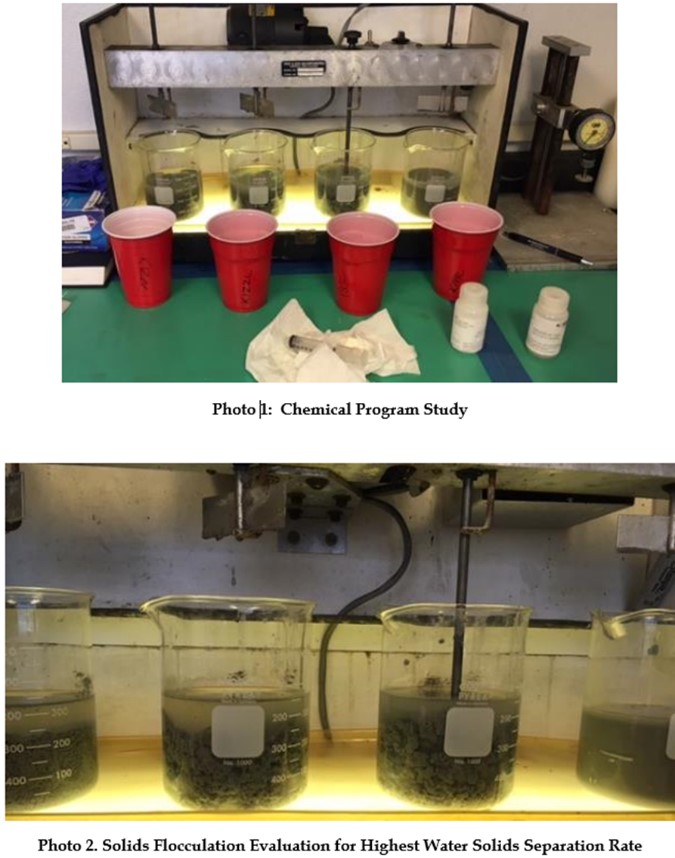
Rapid Dewatering Test (RDT)
The RDT is a fast and easy way to determine how well the sludge dewaters through the GT500 textile. The test is designed to 1) evaluate the efficiency of candidate polymers, 2) measure the volume of the effluent filtered from the sludge, 3) record the time for filtration, and 4) analyze the quality of the effluent water. The RDT shall follow the testing protocol detailed here.
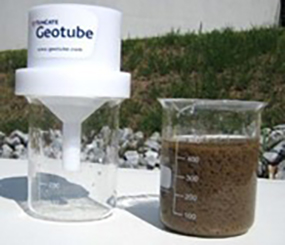
Pressure Gravity Drainage Test (P-GDT)
Following the completion of an RDT for polymer screening, the P-GDT will be performed using a small sample of slurry to simulate full-scale field conditions for a chemically conditioned slurry dewatering project. Once complete, the P-GDT will establish baseline measurements for the use of SmartFeed™ technology that can then be carried forward and applied to an entire dewatering project. The purpose of the P-GDT test is to:
- Visualize the dewatering process
- Simulate physical force interaction between permeability of filter fabric selection and polymer performance under full-scale application pressure
- Confirm chemical program (polymer) dosage is representative of full-scale application
- Create samples of filtrate and filter cake
- Confirm application mass-balance of Geotube® filtration area required for project
- As an example of P-GDT testing, Photo 3 shows the filling of the P-GDT GeoTube “pillow” with Photo 4 presenting the resultant P-GDT filter cake material.

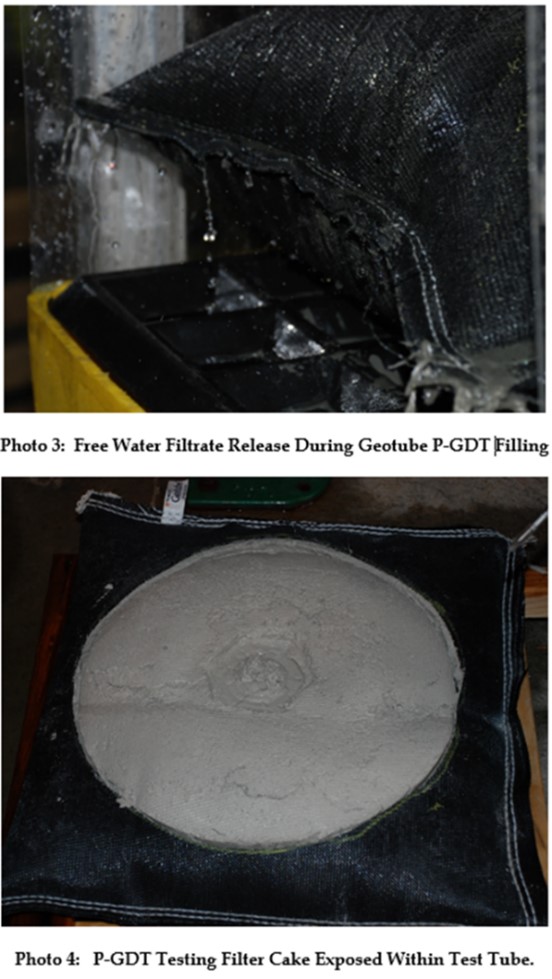
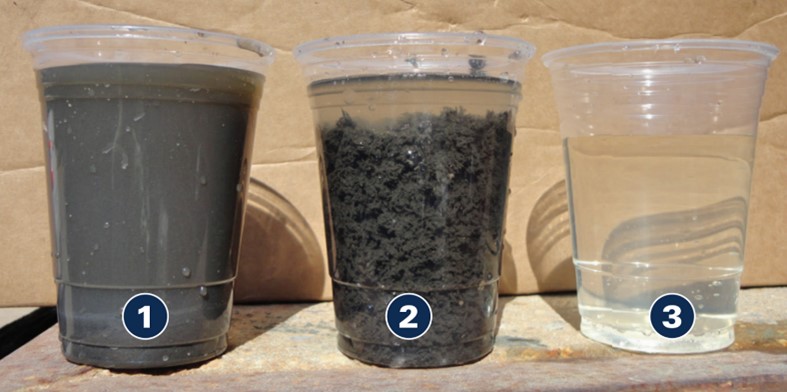

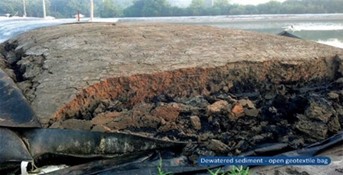
Geotube® Estimator Analysis and Report Preparation
At the completion of the above two bench tests, UMPS will analyze the RDT and P-GDT data using a vendor’s tool Geotube® Estimator to determine sludge dredge rates, dredge dilution percent, estimated sludge generation for disposal, required Geotube® filtration area, and project processing days. UMPS shall submit a Geotube® Dewatering Bench Test Report summarizing the test procedures, recommended polymer(s) and dosage rates, project parameters described above, Geotube® Estimator findings, site drawings of lay-down area, conclusions and recommendations for pilot-scale testing and full-scale application, and ballpark cost estimate for the full-scale application.
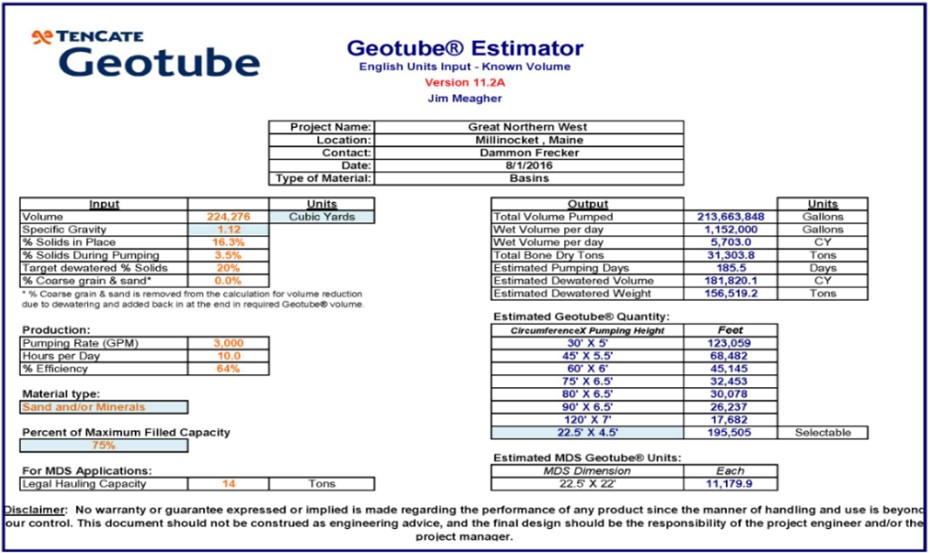
UMPS provides total turnkey project design, underwater imaging, regulatory permitting support, hydraulic dredging, commercial diving, sediment processing and water treatment. Supplemental details on UMPS’ dredge slurry processing and dewatering services can be seen on the UCC/UMPS blog, SEDIMENT / SLUDGE DREDGING & DEWATERING SERVICES.
If you have a potential dewatering project that UMPS can assist on, please go to “Spec Your Project”. Send us the completed form, and you will hear from us soon! Need a quick response? Contact Jim Meagher at 207.741.2955 / [email protected] , or “Contact Us” for any of your pit, pond or lagoon sludge/sediment dredging and dewatering services.
